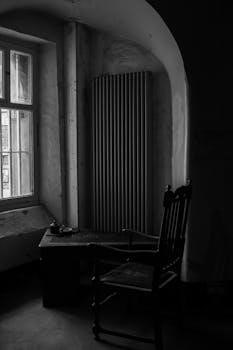
Embark on a journey to uncover the secrets held within antique rocking chairs․ This guide offers essential knowledge to confidently identify‚ date‚ and assess the value of these cherished pieces‚ revealing their unique characteristics and historical significance․
Types of Antique Rocking Chairs
Delving into the realm of antique rocking chairs reveals a fascinating array of styles‚ each possessing unique characteristics and historical significance․ From the elegantly curved lines of Bentwood rockers to the classic charm of Boston rocking chairs‚ the diversity is remarkable․ Folding rocking chairs offer portability and space-saving convenience‚ while Gungstol rocking chairs‚ with their distinctive Swedish design‚ showcase a blend of functionality and artistry․ Jenny Lind rocking chairs‚ known for their spindle backs and delicate details‚ exude Victorian-era charm․ Java Teak rocking chairs‚ crafted from durable teak wood‚ bring a touch of exotic elegance․
Understanding these distinct types is crucial for accurate identification and appreciation․ Each style reflects specific design trends‚ manufacturing techniques‚ and cultural influences of its time․ Recognizing the subtle nuances in shape‚ materials‚ and ornamentation allows collectors and enthusiasts to distinguish between different eras and origins․ By exploring the diverse world of antique rocking chair types‚ one can gain a deeper understanding of their historical context and artistic value‚ enhancing the appreciation for these timeless pieces․
Bentwood Rocking Chairs
Bentwood rocking chairs‚ renowned for their graceful curves and lightweight construction‚ represent a significant innovation in furniture design․ Pioneered by Michael Thonet in the 19th century‚ these chairs are crafted by steaming and bending solid wood‚ typically beech‚ into elegant shapes․ This technique allows for the creation of intricate designs and flowing lines that are both aesthetically pleasing and structurally sound․ The absence of sharp angles and the smooth‚ continuous curves contribute to the chair’s comfort and visual appeal․

Identifying a genuine antique Bentwood rocking chair involves careful examination of its construction and details․ Look for the characteristic steam-bent components‚ including the back‚ seat‚ and legs․ The joints should be seamless and sturdy‚ reflecting the skilled craftsmanship of the period․ Original Bentwood chairs often bear a maker’s mark or label‚ which can provide valuable information about their origin and age․ The overall condition of the chair‚ including any signs of wear or repair‚ can also affect its value and authenticity․ Appreciating the unique features and history of Bentwood rocking chairs enhances the collector’s experience․
Boston Rocking Chairs
Boston rocking chairs‚ a staple of American homes in the 19th century‚ are easily recognizable by their spindle backs‚ scrolled headrests‚ and comfortable scooped seats․ These chairs‚ often painted black or dark green‚ exude a classic charm and evoke a sense of nostalgia․ Their sturdy construction and timeless design made them a popular choice for families seeking both comfort and durability․ The distinctive shape of the back‚ with its multiple spindles and decorative crest rail‚ is a hallmark of the Boston rocking chair style․
When identifying an antique Boston rocking chair‚ pay close attention to the details of its construction and finish․ The spindles should be evenly spaced and securely attached to the seat and crest rail․ The paint or varnish should show signs of age‚ such as wear and crazing‚ which can indicate its authenticity․ Look for the presence of original hardware‚ such as screws or tacks‚ which can also provide clues about the chair’s age and origin․ The overall condition of the chair‚ including any repairs or replacements‚ can affect its value and collectibility․ Understanding the history and characteristics of Boston rocking chairs allows enthusiasts to appreciate their enduring appeal and craftsmanship․
Folding Rocking Chairs
Folding rocking chairs‚ a marvel of ingenuity and practicality‚ represent a unique category within antique seating; Their defining feature‚ the ability to collapse for easy storage and transport‚ made them particularly popular for travelers‚ campers‚ and those with limited space․ These chairs often showcase inventive designs and clever mechanisms‚ reflecting the craftsmanship of their era․ The materials used in their construction can vary widely‚ from sturdy hardwoods like oak and maple to lightweight metals like iron and steel․

Identifying an antique folding rocking chair requires careful examination of its folding mechanism and overall design․ Look for signs of wear and tear on the hinges and joints‚ which can indicate the chair’s age and usage․ The presence of original hardware‚ such as catches and latches‚ can also be a valuable clue․ The style of the chair‚ including its seat and back design‚ can provide further insights into its origin and period․ The condition of the chair‚ including any repairs or replacements‚ will affect its value․ Appreciating the ingenuity and functionality of folding rocking chairs allows us to understand their historical significance and appeal․

Gungstol Rocking Chairs

Gungstol rocking chairs‚ originating from Sweden‚ possess a distinctive aesthetic that sets them apart in the world of antique seating․ Characterized by their high backs‚ spindle designs‚ and often painted surfaces‚ Gungstol chairs embody a blend of functionality and folk art․ The curved rockers‚ typically made of wood‚ contribute to the chair’s gentle rocking motion and overall comfort․ These chairs were traditionally crafted from readily available materials‚ such as pine or birch‚ and then adorned with vibrant colors and decorative motifs․
Identifying an antique Gungstol rocking chair involves paying close attention to its unique design elements․ The presence of a high‚ often ornately carved back is a key indicator․ Examine the spindles for their shape and arrangement‚ as well as the overall construction of the chair․ The original paint‚ even if faded or chipped‚ can provide valuable clues about the chair’s age and origin․ Look for signs of handcraftsmanship‚ such as variations in the wood and irregularities in the paint․ Gungstol chairs represent a charming fusion of Scandinavian design and cultural heritage․
Jenny Lind Rocking Chairs
Jenny Lind rocking chairs‚ named after the famous Swedish opera singer‚ are recognizable for their distinctive spindle design and delicate aesthetic․ Popular during the mid-19th century‚ these chairs were often marketed as nursery furniture‚ providing a comfortable and stylish seating option for mothers and children․ The spindle back‚ typically composed of numerous slender‚ turned spindles‚ creates an airy and visually appealing design․ These chairs were commonly constructed from lightweight woods‚ such as maple or birch‚ and often finished with a clear varnish or painted in light colors․
Identifying an antique Jenny Lind rocking chair involves examining several key features․ The spindle back is the most prominent characteristic‚ so pay close attention to the number and shape of the spindles․ Look for signs of handcraftsmanship‚ such as subtle variations in the turning and joinery․ The rockers should be smoothly curved and securely attached to the base of the chair․ Original finishes may show signs of wear and age‚ but can also provide valuable clues about the chair’s authenticity․ Jenny Lind rocking chairs represent a charming blend of Victorian style and practical functionality․
Java Teak Rocking Chairs
Java Teak rocking chairs‚ originating from the island of Java in Indonesia‚ are renowned for their durability‚ rich color‚ and resistance to the elements․ Crafted from teak wood‚ a dense and oily hardwood‚ these chairs were popular choices for outdoor use‚ particularly on porches and patios․ The natural properties of teak make it resistant to rot‚ decay‚ and insect damage‚ ensuring longevity and minimal maintenance․ Java Teak rocking chairs often feature a simple yet elegant design‚ characterized by clean lines and a smooth‚ polished finish․
Identifying an antique Java Teak rocking chair involves examining the wood grain‚ color‚ and construction․ Teak wood has a distinctive grain pattern and a warm‚ golden-brown hue that deepens with age․ Look for signs of quality craftsmanship‚ such as tight joinery and smooth surfaces․ Check for any maker’s marks or labels that could provide additional information about the chair’s origin and age․ Due to the inherent durability of teak‚ these chairs often survive in excellent condition‚ making them a valuable addition to any collection․ Their timeless appeal and weather-resistant qualities make them a practical and stylish choice for both indoor and outdoor settings․
Maker’s Marks and Location
Identifying the maker of an antique rocking chair can significantly enhance its value and historical significance․ Maker’s marks‚ often subtle and discreet‚ serve as a direct link to the craftsman or manufacturer responsible for its creation․ The most common location for these marks is on the underside of the chair’s seat‚ where they are protected from wear and tear․ However‚ marks can also be found on the back of the chair‚ along the frame‚ or even on the rockers themselves․
These marks may take various forms‚ including stamped logos‚ engraved initials‚ or paper labels․ Sometimes‚ a company name or location is included‚ offering valuable clues about the chair’s origin and period․ When examining a rocking chair for maker’s marks‚ use a flashlight and magnifying glass to carefully inspect all surfaces․ Be gentle when cleaning any suspected marks to avoid damaging them․ Researching identified marks through online databases‚ antique guides‚ and historical records can provide valuable insights into the chair’s history and potential worth․ The presence of a well-known maker’s mark can dramatically increase an antique rocking chair’s desirability among collectors․
Fastening Methods⁚ Glue and Wooden Pegs
The methods used to fasten the components of an antique rocking chair together offer valuable clues about its age and construction techniques․ Historically‚ glue and wooden pegs were common methods employed before the widespread use of screws and nails․ Examining the joints of a rocking chair can reveal whether these traditional methods were utilized․ If glue is visible‚ it is likely a hide glue‚ which was prevalent in earlier furniture making․
Wooden pegs‚ also known as dowels‚ were used to reinforce joints and provide structural integrity․ These pegs are typically visible as small‚ round protrusions on the surface of the wood․ Their presence suggests an older construction method․ Chairs relying heavily on glue and wooden pegs often predate the mass-production era․ In contrast‚ the presence of screws or nails‚ especially those with modern designs‚ may indicate a later production date or repairs․
However‚ it is important to note that some antique rocking chairs may have undergone repairs over time‚ potentially incorporating newer fastening methods․ Therefore‚ a careful assessment of all joints and fasteners is necessary for accurate identification․
Materials Used⁚ Cherry and Walnut
Identifying the wood used in an antique rocking chair is crucial for authentication․ Cherry and walnut were favored for their beauty‚ durability‚ and workability․ Cherry wood boasts a smooth grain and rich reddish-brown hue that deepens with age․ Its fine texture allows for intricate carvings and detailed designs․ Over time‚ cherry develops a characteristic patina that enhances its appeal․
Walnut‚ prized for its strength and elegance‚ ranges from light to dark brown with striking grain patterns․ Its density makes it ideal for crafting sturdy furniture‚ capable of withstanding generations of use․ The natural oils in walnut contribute to its lustrous finish and resistance to decay․ Antique walnut rocking chairs often showcase elaborate carvings and refined details․
To identify these woods‚ examine the grain pattern‚ color‚ and weight․ Cherry tends to have a tighter‚ more uniform grain compared to walnut’s bolder‚ more varied patterns․ Also‚ consider the wood’s finish; original finishes enhance the natural beauty of cherry and walnut‚ while later finishes may obscure the wood’s true character․